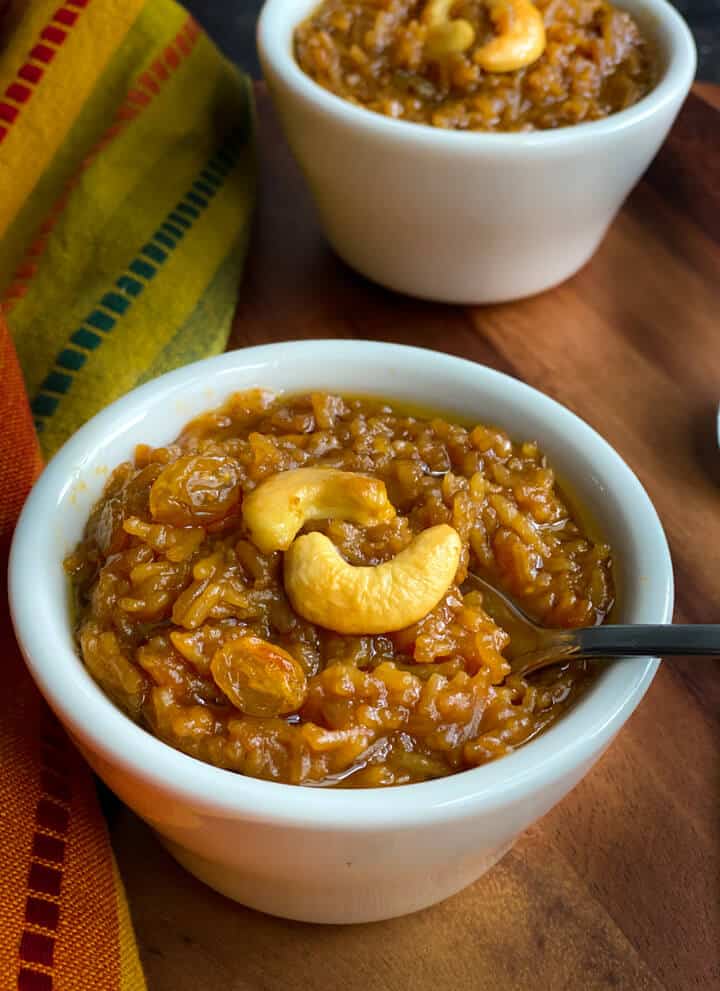Learn the way to make this authentic-tasting Sakkarai Pongal or Chakkara Pongali in under half-hour using an Fast Pot.

Sweet Pongal – cultural significance
When you like South Indian desserts you then’ll fall in love with sweet Pongal – a stupendous brown coloured porridge comprised of rice and moong dal. Cooked in ghee, sweetened with jaggery, and garnished with cashews and raisins, this dessert recipe is totally divine.
It is mostly prepared as prasadam (holy offering to Hindu gods) in South Indian temples especially during Pongal (Tamilnadu) and Sankranthi (Andhra Pradesh).
That doesn’t mean that you could’t take pleasure in it at home every now and then. It’s certainly one of our go-to desserts during cold winters.
Alternate names of this dish
Sakkarai Pongal (in Tamil) and Chakkara Pongali (in Telugu), where each sakkarai and chakkara mean sweet.
Pongal – A transient history
Around mid-January, crops are harvested in India, and as a strategy to express gratitude to God for harvest, celebrations are held all around the country with regional variations.
In Tamil Nadu, the harvest festival lasts for 4 days and is known as Thai Pongal (“boiling over”). On the second day of this festival, rice and milk are boiled in earthenware and are then allowed to overflow.
Everyone shouts “Pongalo Pongal!” which implies while praying for an abundance in harvest, fortune, and prosperity.
Jaggery, cashews, and roasted moong dal are added to the remnant milk and offered to God before serving the remaining to the relations.
That is the sweet version of Pongal, often called Sakkarai Pongal. The savory version called Ven Pongal in Tamil Nadu makes for a hearty breakfast dish.
Read more in regards to the Pongal festival here –
How you can make this recipe
Recipe inspiration
The numerous recipes that you just’ll see on the web recommend that you just cook the rice and dal till it’s mushy. There may be nothing flawed with that, however the version I grew up eating had some texture to it, and that’s the one I’m sharing on this post.
When you like this sweet porridge completely cooked, just increase the cooking time from 6 minutes to 10, and use 3 cups of water as an alternative of two.5.
Ingredient notes

Rice and moong dal are but when combined with the sweetness of jaggery and the nutty, fragrant ghee, it makes this dish hard to withstand. This recipe does call for loads of ghee, but for those who are usually not comfortable with the quantity, be at liberty to scale back it.
- Rice – raw rice is often used for this recipe, but you too can use Basmati rice or sona masoori rice.
- Moong dal – some folks make this dish without this ingredient.
- Powdered jaggery as a sweetener. Jaggery cubes are okay, but you’ll have to cook and dissolve them in water.
- Ghee makes this dish fragrant and fragrant. Here’s a recipe to make homemade ghee.
- Cardamom seeds, powdered
- Raisins and cashews for added taste and crunch.
- Edible camphor, optional – used as a flavor enhancer.
- Liquids – Water, and you’ll be able to add whole milk (or coconut milk for a vegan version) to make it creamy.
Step by Step Instructions
- Wash the rice using a colander and put aside.
- Set the Fast Pot to ‘Saute’ mode and adjust the setting to ‘More’. When the display reads ‘Hot’, add 1/4 cup ghee. Once the ghee heats up, add cashews.
- When the cashews turn golden brown, add raisins. Once the raisins begin to plump up, transfer each cashews and raisins to a plate.
- Add the moong dal (it’s dry and never rinsed) and roast it in the new ghee till it turns golden brown while stirring continually for even browning. This may take 2-3 minutes.
- Add rice and salt together with water (use 3 cups of water to make the Pongal mushy or leave it at 2.5 cups for those who prefer it with a little bit of texture). Mix well. Close the vent and set it to the sealing position.
- Pressure cook under high pressure and set it for six minutes.
- Once the cooking cycle is complete, quickly release pressure.
- Open the lid and add 1 cup of powdered jaggery, and camphor. Mix well to mix. Note 1) No have to turn the Fast Pot on, the jaggery will melt within the residual heat. 2) If using jaggery cubes, see note 4 below on the way to make a syrup
- Do a taste test and add more jaggery if needed.
- Add warm milk together with remaining ghee and blend well to mix. The Pongal will absorb the liquid very quickly. If it is just too thick, add some more warm water or milk. If it has an excessive amount of liquid then saute it for a minute or two on low heat to thicken it.
- Add the roasted cashews, raisins, and cardamom and blend well.
- Serve hot with a dollop of ghee, if desired.
Recipe Notes / Suggestions
- Raw rice is often used for this recipe, but you too can use Basmati rice or sona masoori rice.
- The quantity of water and cook time will vary depending on the rice used. I haven’t tried this recipe with raw rice, but for those who are using sona masoori rice, increase the cooking time to 10 minutes. Use 3 cups of water for a Pongal with some or 4 cups of water to make it .
- I didn’t wash the moong dal before or after roasting. When you would love to, you’ll be able to rinse it and dry it with a paper towel before roasting. Rinsing it after being roasted can also be an option.
- Use powdered jaggery to chop down on cooking time. Traditionally, this recipe is made by adding jaggery chunks (~250 grams) to 1/2 cup of water in a saucepan. The mixture is cooked till it involves a boil and the jaggery is totally dissolved. The syrup is then run through a sieve to filter out any impurities.
- The quality of powdered jaggery varies so start with 1 cup, do a taste test and add more as needed.
- If using edible camphor, use a mortar/pestle to crush it completely, or else there shall be crunchy bits in your dish.
- Use an Fast Pot to chop short the cooking time. You should utilize a saucepan or a conventional stovetop pressure cooker like Hawkins as well.
- Fair warning: Reducing the quantity of ghee on this recipe will impact the taste of the dish. Having said that, for those who are calorie conscious, be at liberty to make use of only 2 tablespoons of ghee, to start with, to saute the cashews and raisins and skip adding the ghee at the top.
Variations
- To make vegan sweet Pongal, replace milk with coconut milk and ghee with coconut oil.
- You possibly can replace jaggery with white sugar or brown sugar. Note: Replacing jaggery with either of those will impact the taste and color.
- Some households don’t use moong dal on this recipe – you’ll be able to skip it as well.
Storing/reheating
Stores well within the refrigerator for about 3-4 days, but it can take in all of the liquid. To bring back the unique consistency, reheat in a microwave or stovetop with a couple of tablespoons of milk or water to melt it.
Other South Indian recipes you’ll love
- Moong dal payasam – In a Mangalorean household, festive celebrations are incomplete with no delicious serving of Moong dal payasam or payasa. Learn the way to make this traditional dessert in half the time without compromising on the taste.
- Ven Pongal – This South Indian breakfast recipe comprised of rice and lentils is an ideal strategy to start your day. Pair it with sambar and chutney for a whole gastronomical experience.
- Fast Rava Idli – Here’s a fast recipe to enjoy those lovely soft fluffy quick rava idlis every time the mood strikes. Serve with coconut or peanut chutney for a delicious and healthy meal.
- Fast Pot Sambar – Sambar or Sambhar is a tangy and mildly spicy lentil-vegetable stew from the southern a part of India. It’s a staple in most South Indian homes and is served alongside idlis or dosas for breakfast or with rice for lunch/dinner.
- Lemon Rice – Got leftover rice? Turn it into Lemon rice – a preferred and flavorful South Indian dish that you could make in lower than quarter-hour.


Fast Pot Sweet Pongal (Sakkarai Pongal or Chakkara Pongali) Recipe
Learn the way to make this authentic-tasting Sakkarai Pongal or Chakkara Pongali in under half-hour using an Fast Pot.
Prevent your screen from going dark
Wash the rice using a colander and put aside.
Set the Fast Pot to ‘Saute’ mode and adjust the setting to ‘More’. When the display reads ‘Hot’, add 1/4 cup ghee. Once the ghee heats up, add cashews.
When the cashews turn golden brown, add raisins. Once the raisins begin to plump up, transfer each cashews and raisins to a plate.
Add the moong dal (it’s dry and never rinsed) and roast it in the new ghee till it turns golden brown while stirring continually for even browning. This may take 2-3 minutes.
Add rice and salt together with water (use 3 cups of water to make the Pongal mushy or leave it at 2.5 cups for those who prefer it with a little bit of texture). Mix well. Close the vent and set it to the sealing position.
Pressure cook under high pressure and set it for six minutes.
Once the cooking cycle is complete, quickly release pressure.
Open the lid and add 1 cup of powdered jaggery, and camphor. Mix well to mix. Note: 1) No have to turn the Fast Pot on, the jaggery will melt within the residual heat. 2) If using jaggery cubes, see the note 4 below on the way to make a syrup.
Do a taste test and add more jaggery if needed.
Add warm milk together with remaining ghee and blend well to mix. The Pongal will absorb the liquid very quickly. If it is just too thick, add some more warm water or milk. If it has an excessive amount of liquid then saute it for a minute or two on low heat to thicken it.
Add the roasted cashews, raisins, and cardamom and blend well.
Serve hot.
Recipe Notes / Suggestions
- Raw rice is often used for this recipe, but you too can use Basmati rice or sona masoori rice.
- The quantity of water and cook time will vary depending on the rice used. I haven’t tried this recipe with raw rice, but for those who are using sona masoori rice, increase the cooking time to 10 minutes. Use 3 cups of water for a Pongal with some or 4 cups of water to make it .
- I didn’t wash the moong dal before or after roasting. When you would love to, you’ll be able to rinse it and dry it with a paper towel before roasting. Rinsing it after being roasted can also be an option.
- Use powdered jaggery to chop down on cooking time. Traditionally, this recipe is made by adding jaggery chunks (~250 grams) to 1/2 cup of water in a saucepan. The mixture is cooked till it involves a boil and the jaggery is totally dissolved. The syrup is then run through a sieve to filter out any impurities.
- The quality of powdered jaggery varies so start with 1 cup, do a taste test and add more as needed.
- If using edible camphor, use a mortar/pestle to crush it completely, or else there shall be crunchy bits in your dish.
- Use an Fast Pot to chop short the cooking time. You should utilize a saucepan or a conventional stovetop pressure cooker like Hawkins as well.
- Fair warning: Reducing the quantity of ghee on this recipe will impact the taste of the dish. Having said that, for those who are calorie conscious, be at liberty to make use of only 2 tablespoons of ghee, to start with, to saute the cashews and raisins and skip adding the ghee at the top.
Variations / Substitutions
- To make vegan sweet Pongal, replace milk with coconut milk and ghee with coconut oil.
- You possibly can replace jaggery with white sugar or brown sugar. Note: Replacing jaggery with either of those will impact the taste and color.
- Some households don’t use moong dal on this recipe – you’ll be able to skip it as well.
How you can store
Stores well within the refrigerator for about 3-4 days but it can take in all of the liquid. To bring back the unique consistency, reheat in a microwave or stovetop with a couple of tablespoons of milk or water to melt it.Disclaimer: Approximate dietary information is provided as a courtesy and may vary depending on the precise ingredients/brands used. If you’ve health issues, please work with a registered dietician or nutritionist.
Serving: 1bowlCalories: 352kcalCarbohydrates: 53gProtein: 6gFat: 13gSaturated Fat: 7gCholesterol: 30mgSodium: 56mgPotassium: 56mgFiber: 2gSugar: 26gVitamin A: 49IUCalcium: 41mgIron: 1mg



